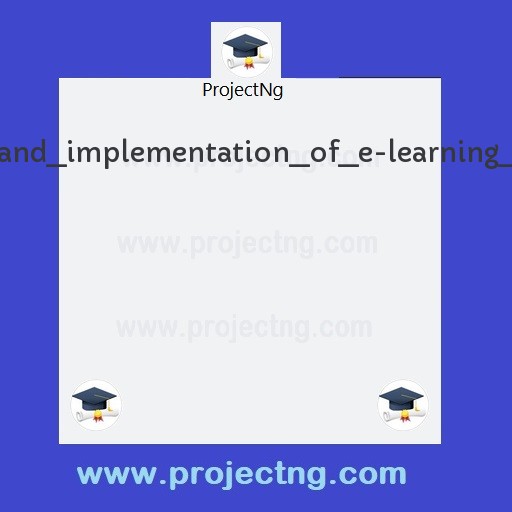Design and implementation of e-learning system
Computer Engineering Project Topics
Get the Complete Project Materials Now! »
DESIGN_AND_IMPLEMENTATION_OF_E-LEARNING_SYSTEM
CHAPTER ONE
1.0 INTRODUCTION
E-learning refers to the use of various kinds of electronic media and information and communication technologies (ICT) in education. E-learning is an inclusive terminology that encompasses all forms of educational technology that electronically or technologically support learning and teaching. Depending on whether a particular aspect, component or delivery method is given emphasis, e-learning may be termed technology-enhanced learning (TEL), computer-based training (CBT), internet-based training (IBT), web-based training (WBT), online education, virtual education, or digital educational collaboration.
E-learning includes numerous types of media that deliver text, audio, images, animation, and streaming video, and includes technology applications and processes such as audio or video tape, satellite TV, CD-ROM, and computer-based learning, as well as local intranet/extranet and web-based learning. Information and communication systems, whether free-standing or based on either local networks or the Internet in networked learning, underlay many e-learning processes.
E-learning can occur in or out of the classroom. It can be self-paced, asynchronous learning or may be instructor-led, synchronous learning. E-learning is suited to distance learning and flexible learning, but it can also be used in conjunction with face-to-face teaching, in which case the term blended learning is commonly used.
It is commonly thought that new technologies make a big difference in education.[2] Many proponents of e-learning believe that everyone must be
2
equipped with basic knowledge of technology, as well as use it as a medium to reach educational goal.
1.1 Background of study
E-learning is an inclusive terminology for all forms of educational technology that electronically or technologically support learning and teaching. Bernard Luskin advocates that the "e" should be interpreted to mean "exciting, energetic, enthusiastic, emotional, extended, excellent, and educational" in addition to "electronic." This broad interpretation focuses on new applications and developments, and also brings learning and media psychology into consideration.
The worldwide e-learning industry was estimated to be over $48 billion in 2000 according to conservative estimates. Developments in internet and multimedia technologies are the basic enabler of e-learning, with consulting, content, technologies, services and support being identified as the five key sectors of the e-learning industry. Information and communication technologies (ICT) are used extensively by young people.
E-learning has given people in college accessibility to data, wherever one looks data of e-learning is there, there are many different sometimes mobile devices as well as their many ways that these benefit people around the globe anytime, anywhere access to data. This can improve interactions between students and their instructors for their classes, this can allow students with tools which they can use for different purposes and use independently supports problem base actions. There are also ways that it can deter people from actually learning as pointed out, it may make it easier to chat taking someone away from learning and into talking to someone through Face book it also gives them the ability to cheat through online test and quizzes having the ability to look for the
3
answer using Google it always a possibility. This also can give tech-savvy students an advantage over non-technical students. Over all e-learning through technology will most likely be seen more and more in today’s college environment. Approaches to e-learning require a focus on students providing them with tools to support their shared activities and problem based activities
1.2 Statement of the study
Student in tertiary institution suffers a lot of setback in external exams due to the type of teaching system which they receive. They don’t have access to the internet and lack knowledge of what is obtainable in the society.
Be the First to Share On Social

Enjoying our content?
Don't miss out on new videos! Subscribe to our YouTube channel for more awesome content.
Subscribe Now!













